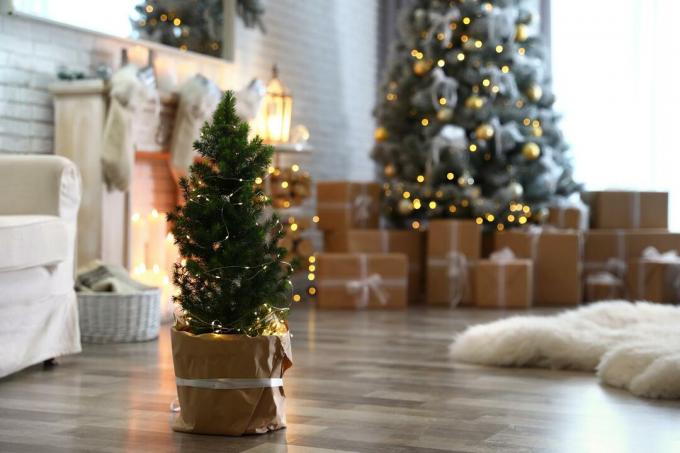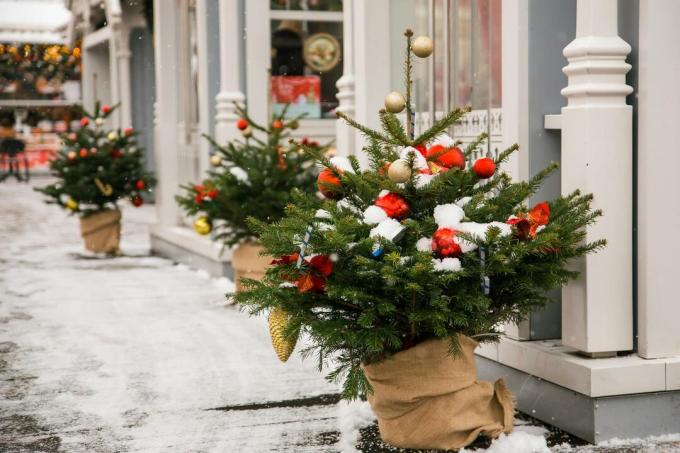Buying a Christmas tree in a pot that you can reuse every year sounds like a great and sustainable idea at first. But does it really work? We reveal whether fir trees will last for several years in a pot.

What would Christmas be without a beautiful Christmas tree? For many, the decorated Christmas tree is indispensable for Christmas. But the nicely decorated tree is more and more criticized: especially the fact that the Throwing away a Christmas tree in the apartment after just a few weeks pisses off many people on. The Christmas tree in the pot, which is not felled, but can continue to grow as a houseplant or garden plant after Christmas should provide a remedy. You can find out here whether this new trend really represents a sustainable alternative and what care the Christmas trees in pots need.
contents
-
Christmas tree in a pot: does it really work?
- Benefits of Christmas trees in pots
- Disadvantages of Christmas trees in pots
- Caring for the Christmas tree in the pot properly
- Plant out the Christmas tree in the garden
Christmas tree in a pot: does it really work?
Many doubt that it is actually possible to cultivate a Christmas tree in a pot permanently and thus do without the annual Christmas tree purchase. In truth, however, this trend can also be implemented relatively easily in your own home if you have a few tips knows: You should be particularly careful when buying, because not all trees are potted for a Christmas tree suitable. Plants in particular that were grown outdoors until shortly before they were sold, usually perish after a certain period of time, as their sensitive roots were damaged when they were potted. Therefore, fir trees that have been grown in pots from the start are much better suited to life as a sustainable Christmas tree. The type of tree is also of crucial importance for the successful survival of the Christmas tree: Firs (Abies), especially the popular Nordmann fir (Abies nordmanniana), are not particularly suitable for keeping pots as they form a deep taproot. As a substitute for the fir tree in the pot, however, mainly spruce (Picea) in question - as shallow roots, they also feel comfortable in a tub.
Benefits of Christmas trees in pots
As an alternative to the classic Christmas tree, the strength of the Christmas tree in the pot lies primarily in its sustainability: instead of To get a Christmas tree from a large monoculture every year, the Christmas tree in the pot can be used for several years will. However, many of the potted trees come from such large plantations and are therefore with one This is a burden on the environment, as the large Christmas tree monocultures often contain pesticides and Artificial fertilizers is being worked on. However, you can avoid this unpleasant side effect by choosing a tree of regional origin and organic forestry when you buy it.

In addition to their sustainability, the Christmas trees in the pot collect another plus point due to their diverse uses. After Christmas, the plants can continue to be used as potted plants, but they can also be relocated to the garden. Those who do not have the time or inclination to look after the Christmas tree for the rest of the year can also take advantage of loan offers: the Christmas trees can be found here can be borrowed over the holidays and later returned to their lender, who will then take care of the further care of the tree takes care. Finally, the Christmas tree can also convince in terms of appearance and symbolism: In contrast to the typical Christmas tree, the variant has needles not so strong in the pot and will convince even after years with its nostalgic charm, which is reminiscent of past Christmas parties.
Disadvantages of Christmas trees in pots
Unfortunately, there are more than positive sides to the fir in the pot. The biggest point of criticism that is repeatedly cited against this variant is the limited variance in optics. On the one hand, this is due to the fact that many well-known types of Christmas tree, such as the Nordmann fir, are only conditionally suitable for keeping pots. In addition, you usually have to be satisfied with small Christmas trees in the pot - larger trees need an extremely bulky pot due to their roots, which is associated with an immense weight were.
In addition, it must be remembered that the Christmas tree in the pot ensures a maintenance effort that should not be underestimated all year round. Like any other container plant, the conifer in the pot must be watered and fertilized regularly. In addition, the plants should be repotted from time to time to allow them to grow properly. The care of the evergreen trees is also made more difficult by the fact that they always react with delay to care errors - that's how it is The actual cause of the tree's sickness is often difficult to identify, as the fault has been around for several weeks behind.

Caring for the Christmas tree in the pot properly
If you decide on a Christmas tree in a pot, the right care is essential to be able to present a healthy tree on Christmas Eve. Among other things, it is particularly important that the Christmas tree is bought early enough - Before he moves into the heated living room, he should have acclimatized for a week to be allowed to. To do this, the Christmas tree is first placed in a cool, unheated place, for example a hallway or winter garden. If the Christmas tree does not get this acclimatization phase, it quickly loses needles and looks sickly.
When you arrive in the living room, choosing the right space is crucial: Conifers like hot air from the heating system Not at all, which is why ideally the coldest point in the room should be chosen as the location for the Christmas tree should. Spruce trees particularly like to be in light to partially shaded areas, while fir trees also like shady areas in winter. If possible, the Christmas tree should be watered every two days with lukewarm water, but make sure that no waterlogging occurs. In addition, the needles can be moistened with a spray bottle to prevent them from drying out due to the warm air from the heating system.

If you want to have something from your Christmas tree in a pot for a longer period of time, you should set it up in the warm living room for a maximum of ten days. Then the Christmas tree in the pot should slowly get used to a colder environment and a new location in the fresh air should be found. Conifers often cannot tolerate a permanent stay in a warm apartment.
If the fir tree remains in the pot for the rest of the year, it needs additional care. After the first frosts, it is advisable to add some pine fertilizer to the pot to provide the tree with sufficient nutrients. In addition, the fir tree must be repotted every few months, especially in the beginning, in order to be able to grow optimally. The new pot should be about ten centimeters larger than the old one and will be about a hand's breadth with it Rhododendron soil filled. This is particularly suitable for firs and spruces, as it has an acidic pH value, as is often required by conifers. When repotting yourself, you should make sure that no roots are damaged. After repotting, the Christmas tree should be watered and great importance should be attached to coordinated watering in the following days.
Plant out the Christmas tree in the garden
In addition to cultivation in the tub, many would like to plant their tree in their home garden after Christmas. In order for this to work, it is particularly important that a suitable location is selected for the tree: Many conifers reach great heights and should therefore be planted with care. Firs and spruces prefer light to partially shaded locations with a rather moist soil, but are often not particularly picky about their soil requirements.
Once a suitable location for the Christmas tree has been found, it is time to prepare for planting meet: Dig a hole that is at least ten inches deeper than the underground parts of the Plant. Now the Christmas tree is carefully freed from its old pot - here you should make sure that no roots are damaged. The conifer now moves into the intended hole, which is filled with earth and some humus. However, it is important to ensure that the trunk is not covered with soil. For the first three weeks after digging in, the tree should be watered vigorously every day.

The perfect time to plant out the Christmas tree is from mid-March, because it should only take place in frost-free soil and late frosts should also no longer occur if possible. However, digging up again for next Christmas is not recommended - this would damage too many roots, which in the worst case could lead to the tree's death. Instead, Christmas trees that have been planted should be allowed to enjoy life in the garden all year round.
Like your Recycle the Christmas tree in other ways you can find out here.



